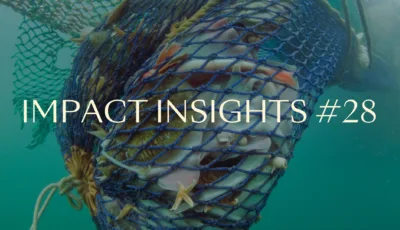5 Impact Trends to Keep an Eye on in 2024

Impact investing shows no signs of slowing down. Despite the lingering effects of global macro challenges on global markets, impact is increasingly becoming mainstream. Sources of capital are multiplying, and there is significant growth in capital allocation volume, according to recent GIIN research. Amidst the rising awareness and interest in impact investing, which trends will make their mark in this space in 2024?

1. Food systems take the center stage
Food systems are responsible for a third of global anthropogenic GHG emissions, and their transformation is increasingly receiving the attention it deserves. COP28 Climate Summit in December 2023 marked a turning point for systems thinking, finally recognizing that sustainability issues are interconnected and interdependent. 130 countries signed a Declaration on Sustainable Agriculture, Resilient Food Systems, and Climate Action, and FAO released a road map detailing milestones for COP 29 and 30 to achieve SDG 2 (“Zero Hunger”) without breaching the 1,5 degrees threshold. Sustainable food systems were framed as a tool to reach global goals.
According to the Food Systems Economics Commission, transformation of the global food systems represents a USD 10 trn annual return opportunity for investors. The GIIN’s 2023 research into allocations shows that more than 60% of impact investors already allocate to food systems, making it the most common investment sector, and a 15% annual growth in AUM allocated between 2017 and 2022. More investment funds also specialize in food and agriculture: 920 today versus only 50 in 2005.
There is no doubt that food systems investments are on an ascent. The increased recognition and awareness of food systems as a keystone to fighting climate change, biodiversity loss and social inequality - supported by the COP28 declarations - will likely propel the sector forward in 2024 and beyond.
2. Continued momentum for nature and biodiversity - finally seeing the light in the carbon tunnel?
Tackling climate change and biodiversity loss must go hand in hand. Markets are finally starting to grasp that nature is an enabler of climate adaptation and mitigation and that the “carbon tunnel” can be a trap for investors looking to address the global environmental crisis. The term refers to an approach where we become overly fixated on CO2 emissions and fail to consider other factors of climate and environmental deterioration that are part of the cohesive whole — as nature and biodiversity provide us with key services such as food, medicine, and landscape resilience for our communities among others.
The UN Biodiversity Conference (COP 15) and the launch of the framework for nature and biodiversity (Kunming-Montreal Global Biodiversity Framework - GBF) in 2022 put nature in the spotlight with the overarching goal dubbed “30 x 30”; protecting 30% of the planet and restoring 30% of degraded land by 2030. COP28 offered biodiversity an additional boost; as the final text referenced the Kunming-Montreal Framework, it must now be integrated into governments’ plans for climate action.
With this, nature-based solutions have quickly climbed on regulators’ and investors’ watchlists. Despite current finance flows to nature-based solutions of USD 200 billion, we need 3x growth in investments in nature-based solutions by 2050. Needless to say, this requires us to quickly pick up the pace on investments while radically decreasing nature-negative activities. Currently, UNEP estimates private finance flows with a direct negative impact on nature at US$5 trillion — 140 times the financing gap for nature-based solutions. The same report points out that public subsidies harmful to the environment reach USD 1,7 trillion, surpassing the size of the global impact investing market, currently estimated to be just below USD 1,2 trillion.
In a 2023 report, the European Investment Bank points out that “nature-based solutions, whether traditional or innovative, provide us with almost a quarter of the most cost-effective climate actions and help biodiversity to thrive, yet they are still on the margins of global finance.”
But there are signs that biodiversity and nature-themed funds will become all the rage in 2024. Assets under management in European funds with a biodiversity focus quadrupled between 2022 and 2023, and companies and investors are increasingly committing to nature and biodiversity-related targets in the context of the Taskforce on Nature-related Financial Disclosures (TNFD) framework.
3. Tightening the net on greenwashing
After an avalanche of disclosure regulations these past years, new rules and bans destined to tackle greenwashing have been adopted in the EU, the UK, and the US. Measures such as the EU ban on generic environmental claims, the UK ruling against airlines’ misleading advertising and the US Names Rule — should start to make a dent in greenwashing practices sooner rather than later.
The EU’s SFDR is also approaching its second anniversary and is already subject to a round of revisions following market consultations. Discussions have been buzzing on whether the regulation is fit for purpose, especially in the context of impact funds looking to drive positive social or environmental change.
Among hot contenders for revision are the categories of funds. The fund categories may be adjusted in line with the UK’s Sustainability Disclosure Requirements (SDR), including a separate category for impact investing. There are also discussions about turning the categories into official fund labels. The use of the SFDR categories as labels is already standard practice in the industry, even though it’s not meant to be used as such by the regulation in its current shape. Establishing these categories as labels would bring the industry’s current practices back under EU control.
We increasingly see the contours of a fine mesh of regulation that – considered as a whole – turn any unsubstantiated green claim into considerable business risk. Integrating sustainability considerations into all aspects of business is becoming a license to play. With implementation timelines coming up quickly, 2024 might be the year this realization hits the mainstream. This also means companies must approach sustainability in a proactive rather than a reactive way to stay ahead of the curve and allocate sufficient resources to the sustainability area.
4. A pivotal year for private investment in emerging markets?
Billions of dollars are invested annually toward achieving the UN Sustainable Development Goals, but trillions are needed to get the goals on track by 2030. The UN’s 2023 stocktake of SDG progress shows that 85% of all SDG indicators are off track, and none are on track for achievement by 2030. The financing gap for emerging markets and developing economies is particularly severe: $3.9 trillion annually, according to estimates of the Impact Taskforce. Their 2023 State of Play report also highlights that private capital flows to emerging economies dropped 22% over the past two years.
But there are signs of movement: a 2023 GIIN report highlights that many investors plan to increase their allocations to emerging market regions over the next five years, focusing on sectors that can help communities meet basic needs.
As the global impact investing community matures and increases in sophistication, there is rising awareness of the need to focus on areas with significant challenges where there is considerable impact potential. Over the past decade, many impact investors have focused on solutions for developed markets, where the impact potential can be marginal. Good impact practice should seek additionally — helping achieve an outcome that might otherwise not happen. In this case, impact potential lies in identifying solutions benefiting the “underserved”. Investments in emerging markets are hence quickly become a “must” for leading impact investors prioritizing additionality.
Catalytic capital has recently been highlighted as a means to achieve a just transition and unlock high-impact opportunities that would otherwise not be possible. Nick Hurd, former UK minister, now leader of the Impact Taskforce and GSG chair, recently stated that “2024 has to be a pivotal year (...). We need a concerted effort to make it easier and more compelling or private investors to help fill the SDG funding gap”.
5. Growing confidence in return perspectives for impact investments
The lack of a track record of financial and impact returns is a well-known challenge for impact-savvy asset managers. Unless highly impact-driven, allocators tend to favor more established managers with solid proof of performance.
But there is a wind of change. Increasingly, family offices built on a strong desire to solve specific sustainability issues are looking to back emerging asset managers that are purpose-built for impact investing. A common rationale for this is that there is no time to turn around traditional asset management — where you need to navigate legacy investments and ESG approaches with impact results that leave much to be desired. One example is Capricorn Investment Group’s Sustainable Investors Fund, which is dedicated to the next generation of impact-oriented investment management firms*, bridging gaps in impact investing.
Household name foundations are also increasingly signaling that they wish to allocate catalytic capital by backing first-time funds with credible impact theses that align with their mission. However, what’s changing is the increasingly mainstream conviction that impact investing will bring market-rate returns — or even above market-rate returns.
The GIIN’s recent research on investors globally shows that three-quarters of impact investors target risk-adjusted market-rate returns, while the remaining target below-market-rate returns. More interestingly, according to 79% of the sample, the performance of their investments met or exceeded their financial targets. This combines with 88% stating that they met or exceeded their impact targets.
A piece of research conducted by the Norwegian National Advisory Board for Impact Investing (NorNAB) — although focusing on the Norwegian impact investing market — highlighted that 45% of surveyed impact investors believe impact can lead to returns above market rate.
These findings show that we’re about to bust one of the most prominent myths in impact investing: that returns are necessarily concessionary. As the market continues to mature, there will only be more proof of the benefits of impact investing — both in solving pressing problems and securing returns. 2024 may just be the year where this gains more visibility and awareness, inspiring more investors to take the impact route to returns.
*The Sustainable Investors Fund holds a 20% share of Norselab Group.
This article is written with contributions from Inès van Tol and Christiaan Griffejoen.


